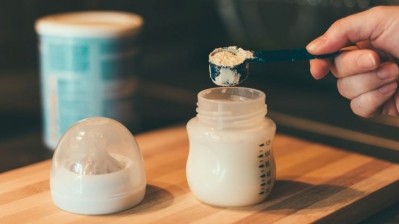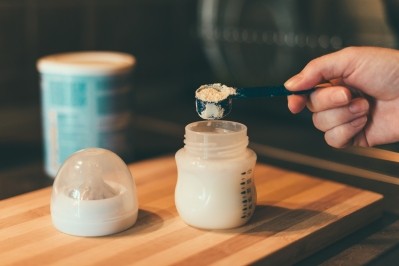Strap: ‘There is no difference between the molecule we make and the molecule in human milk’
WATCH: Infant formula… the next generation? Sugarlogix deploys microbial fermentation to grow sugars found in human breast milk
There’s still a lot we don’t know about the 180+ HMOs in breast milk, Sugarlogix co-founder Chaeyoung Shin told FoodNavigator-USA at Rabobank’s FoodBytes! summit in San Francisco.
But we do know that humans lack the enzymes to process them, such that most of these sugars reach babies’ intestines undigested, where they nourish a particular subspecies of beneficial bacteria called B.infantis, which increase the acidity in the gut, making it more hostile to pathogens, and is associated with better health outcomes later in life, she said.
(Click HERE and HERE for more details.)
“HMOs are not meant to be used as energy sources for the human body,” said Shin, who served as a mentor to start-ups pitching at the FoodBytes! event (having previously scooped a prize at a FoodBytes! event in Austin).
“Rather they feed the beneficial gut bacteria very selectively… starving the bad bacteria and promoting the growth of beneficial bacteria, which in turn helps our gut flourish and which is also connected with our nervous systems and our immune system.”
The initial focus will be infant formula
Sugarlogix is initially targeting the infant formula market, and may also explore whether to add HMOs to products for adults, although right now it is less clear whether this would benefit the adult microbiome, or whether HMOs only work their magic during a key developmental window in infancy.
However, a 2016 clinical study with 100 adults showed that HMO supplementation prompted increases in Actinobacteria and Bifidobacterium in particular and a reduction in Firmicutes and Proteobacteria, so this may be an avenue worthy of further exploration, said Shin.
"Few studies have been conducted in adults but preliminary findings have shown that similar enhancement in the gut microbiota composition was observed for adults as well."
Sugarlogix uses yeast rather than E.Coli to make HMOs
Right now, Sugarlogix is focusing on the most prevalent HMO, 2′-fucosyllactose, which some other companies such as DuPont are currently producing from modified E.Coli bacteria [the FDA recently said it had no objections to the firm’s determination that 2’FL produced in this way is safe].
Sugarlogix, however, has found a way to produce 2’FL from yeast, which Shin claimed sets it apart in a small, but rapidly growing, field: “Many different players are using different approaches. All of the first generation technology is based on E.coli production and we are leading the second generation technology to utilize yeast. We are not aware of any yeast processes in commercial scale. We use baker's yeast, a microorganism that has been well-incorporated in our everyday diet. By using a food-friendly organism, our technology allows us to have regulatory, marketing, and sustainability advantages."
So far, Sugarlogix has raised about $2.5m from "various sources including grant, accelerator, and VC investors," said Shin.
"We are in active conversations with multiple companies who are interested in pursuing collaboration with us. We are not ready to disclose which companies but can share that we are receiving a lot of sample requests."
A 2016 study from researchers at Abbott Nutrition, which makes Similac, found that when babies were fed formula with 2′-FL (the same HMO that Sugarlogix makes), they had an immune response more similar to breastfed babies. 2’FL made from microbial fermentation is now used in Similac Pro-Advance formula.
The GMO factor
But what about the ‘GMO factor’? Sugarlogix is deploying synthetic biology techniques to insert gene sequences into the yeast that serve as code to ‘instruct’ it to produce target molecules such as 2’FL. And while none of the modified yeast remains in the final products, could this deter some formula manufacturers worried about anti-GMO sentiments?
It shouldn’t, said Shin, who noted that HMOs produced using genetically engineered E.Coli are already used in high profile infant formula brands, and that the benefits around this technology are not about saving money, or higher yields, but enabling game-changing products that enable Moms who cannot breastfeed to buy something as close as possible to human breast milk: the Holy Grail in infant formula.
She added: “There is no difference between the molecule we make and the molecule in human milk. We’re not trying to cut costs, we’re trying to do something that’s very difficult to do outside the human body.”
While Sugarlogix is focusing on oligosaccharides (carbs) in breast milk, San Diego-based Triton Algae Innovations is exploring algae as a production platform for proteins found in human breast milk such as osteopontin.
Instead of yeast or E.Coli, uses Chlamydomonas reinhardtii, a single-celled freshwater green algae species that can grow heterotrophically in fermentation tanks, with the ability to express multiple proteins found in plants and mammalian cells including bovine and human osteopontin.
“We’re using synthetic biology and introducing a gene into [the chloroplast genome of] of Chlamydomonas reinhardtii. These proteins already exist in nature, we’re just creating them another way,” Miller Tran, PhD, Triton cofounder and director of R&D, told FoodNavigator-USA in a recent interview.
“We’re talking to a lot of infant formula companies, because they can really see the potential. As far as we know, we’re the only company able to produce these using microalgae.”


















